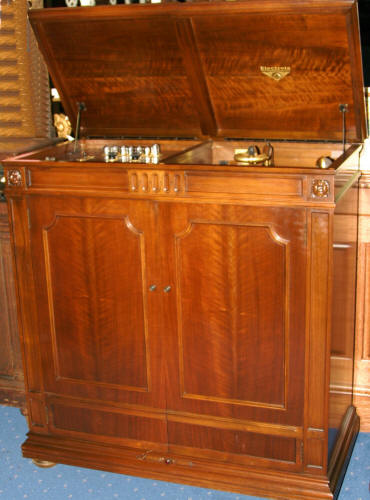
The Victor-Victrola Page
 VE 9-40E
VE 9-40E
RARITY: ¤¤¤ VALUE: ¤¤


 The
VE 9-40 represented a minor upgrade to the earlier
Borgia II model. When introduced in the final
months of 1926, the 9-40 was the top-of-the line machine in Victor's product
lineup. It featured an RCA-produced Radiola Model 28 radio
(RCA's best set) and Victor's premium Orthophonic
and Electrola phonograph with a large folded horn of similar dimensions
as that used in the famous "Credenza" model. A small electromagnetic
driver was coupled to the neck of the horn, which allowed the radio's output to
be heard with excellent volume and fidelity. The user would then switch a large
valve to change the horn's input from the radio to the tone-arm when records
were played. For record playback, the user of the 9-40 could select either acoustical reproduction or electronic
reproduction, as there were two phono pickups attached to the tonearm
(picture on right). A large tube amplifier provided
audio power from the electric pickup to the horn's electromagnetic driver. The
only difference between the 9-40 and its Borgia II predecessor was an improved
amplifier design, resulting in slightly reduced noise levels. If the user tired
of listening to electrically amplified records, he could simply switch-over to
acoustic reproduction, which disabled the amplifier and provided a direct
coupling of the horn to the Orthophonic soundbox, thus eliminating any unwanted
artifacts of distortion and/or noise, which still remained problematic in the
early days of audio electronics.
The
VE 9-40 represented a minor upgrade to the earlier
Borgia II model. When introduced in the final
months of 1926, the 9-40 was the top-of-the line machine in Victor's product
lineup. It featured an RCA-produced Radiola Model 28 radio
(RCA's best set) and Victor's premium Orthophonic
and Electrola phonograph with a large folded horn of similar dimensions
as that used in the famous "Credenza" model. A small electromagnetic
driver was coupled to the neck of the horn, which allowed the radio's output to
be heard with excellent volume and fidelity. The user would then switch a large
valve to change the horn's input from the radio to the tone-arm when records
were played. For record playback, the user of the 9-40 could select either acoustical reproduction or electronic
reproduction, as there were two phono pickups attached to the tonearm
(picture on right). A large tube amplifier provided
audio power from the electric pickup to the horn's electromagnetic driver. The
only difference between the 9-40 and its Borgia II predecessor was an improved
amplifier design, resulting in slightly reduced noise levels. If the user tired
of listening to electrically amplified records, he could simply switch-over to
acoustic reproduction, which disabled the amplifier and provided a direct
coupling of the horn to the Orthophonic soundbox, thus eliminating any unwanted
artifacts of distortion and/or noise, which still remained problematic in the
early days of audio electronics.
All these components were enclosed in a massive walnut cabinet that measured 44"
wide and over 45" tall. The 9-40 shared an identical cabinet and appearance both
the Borgia II and Borgia I.
The 9-40 sold for $1,000.00 (the same price as the Borgia II), which equates to
almost $15,000.00 in today's money. The 9-40 took over the title of 'the ultimate audiophile dream-machine'
in late 1926; however, like the Borgia II, it quickly became obsolete with the introduction of the vastly
improved performance of paper-cone speakers in 1927.
The VV 8-60 model was
the 'little brother' version of the 9-40, as it shared the dual-playback
capability for records, but did not have a radio.
While few have survived, the imposing size and cost of restoration of these
early and complex models limits the interest of most collectors in the current
market.
Rebuilding of the amplifier alone can
cost well over $500.00.
Given the high cost when new, a surprising total of approximately
5,100 9-40 models were produced, and all were manufactured during 1926. It
remained available at dealers well into 1927, and was
likely being significantly discounted by that time.
The current survival database shows the earliest existent VE 9-40 to be S/N 662 and the latest to be S/N 4259.
Do you own a Victor 9-40? Please take a moment and enter some basic information about your machine into the collector's database by clicking here. No personal information is required.